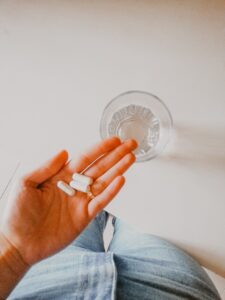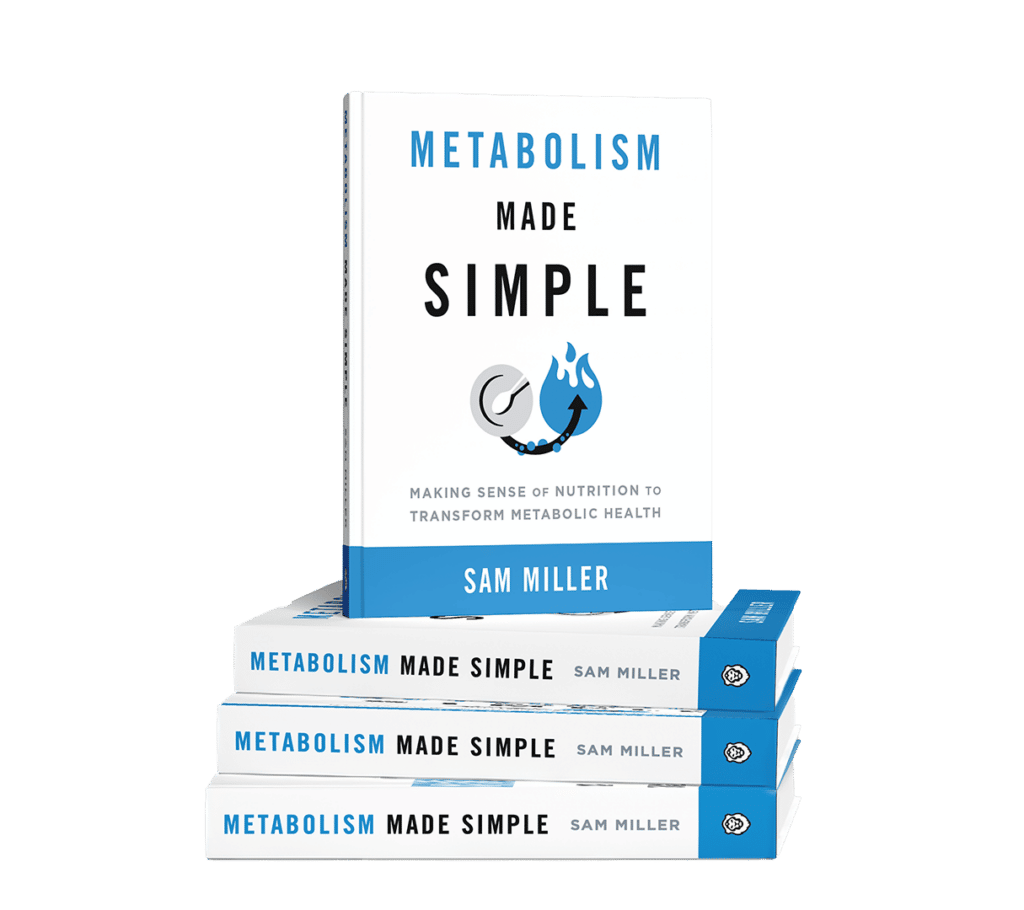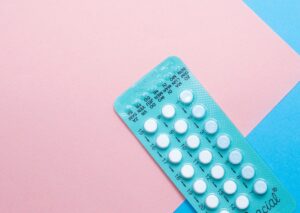Introduction – Effects of Menopause
Menopause is an inevitable event that every woman has to go through. For most, it comes with symptoms like night sweats, hot flashes, slow changes to body composition, and other potentially negative aspects. Going through menopause comes with significant changes to the body.
The lack of circulating ovarian hormones, namely estrogen and progesterone, has whole-body consequences, including increased risk of anxiety and depression, less insulin sensitivity, and more propensity for visceral fat storage, which increases risk for metabolic disease, increased risk of cardiovascular disease, and increased risk of osteoporosis amongst other changes in quality of life.
It also makes it a bit harder to lose fat, put on muscle, and have the body composition that most people seek.
It doesn’t have to be that way, though. Much, although not all, of these changes are caused by the loss of circulating sex hormones, so many women seek out hormone replacement therapy post-menopause to help mitigate these issues.
Unfortunately, thanks to the blunder that was the WHI (Women’s Health Initiative) study, which was the largest study looking at the consequences of HRT in women, many female patients and physicians alike are still terrified to prescribe it. Let’s go ahead and examine that.
Why the WHI Scared People Away from HRT
When many women hear about post-menopause HRT, they have instant visceral reactions and thoughts of breast cancer or other negative effects. This isn’t totally unwarranted and comes from the WHI data, which we now know that the study was not conducted in an ideal manner, but even more-so was poorly interpreted.
Many found the results surprising. Although there was a good amount of benefits, there was an indication that some types of HRT increased risk of breast cancer and certain cardiovascular complications like clotting and stroke.
Since then, many women have been quite hesitant to engage in HRT and many doctors have also been hesitant in prescribing it. There is a little more nuance involved to the conversation, however.
There are tons of benefits to HRT, even seen in the original WHI study: Decreased risk of osteoporosis and fractures, decreased risk of metabolic disease and type 2 diabetes, decreased risk of coronary artery disease, decreased all-cause mortality.
In addition to the long term disease-reducing effects, there were immediate benefits too: an overall increase in quality of life when it comes to mood, libido, sexual function, and energy. This is all while easing the actual symptoms of going through menopause, meaning no more hot flashes, night sweats, and insomnia associated with decreased sex hormones.
However, some of the negative aspects that surfaced were possible increases in breast cancer risk, thromboembolism, clotting, and stroke. Bear with me, if HRT is done right, alot of those risks can be mitigated almost completely, so we’ll dive into the nuance of all this in just a bit.
Optimal HRT – Route of Administration, Age upon starting, and Type of Hormone Matters
The main considerations are going to be the time course of when someone starts HRT in relation to menopause, the type of HRT used and route of administration, and co-moborditities present prior to HRT beginning.
Time Course:
One of the main determinants in the risk vs. benefit equation is the time after menopause at which HRT is started. Many of the negative effects that were originally attributed to HRT in general, especially in terms of negative cardiovascular effects and stroke, were actually really only seen if someone started HRT very late; 10 or so years after menopause or after age 60.
If HRT is started within proximity to the menopause transition, we see a lot of those risks actually disappear and the benefits far outweigh the risks in that situation. The most likely optimal time to start HRT is actually perimenopause, when you first start feeling symptoms of the transition, but barring that, within 10 years of going through menopause.
Type of Hormone:
Another consideration would be type of hormone replacement. There exists a lot of different types, like conjugated equine estrogens, which are a combination of different estrogens derived from horse urine (this was the type used in the WHI study, which contributed to some of the findings), synthetic estrogens like ethinyl estradiol, and then bioidentical estrogens like E2, E1, or E3.
Progesterone is similar in the fact that there’s many types. We have micronized bioidentical progesterone and then synthetic progestogens like medroxy-progesterone acetate (MPA; also used in the WHI study and responsible for some negative effects seen) or norethindrone.
If a woman is planning on undergoing HRT and still has a uterus (has not had a hysterectomy), then progesterone has to be used in combination with estrogen to avoid an increase in endometrial cancer risk.
It’s now clear that the bioidentical forms are the way to go. I’ll also add that bioidentical hormone preparations from compounding pharmacies should probably be avoided or at least you should do considerable research into the compounding pharmacy you’re interested in.
These are not as regulated as FDA-approved formulations. The FDA has also approved bioidentical hormone therapy, so you don’t have to resort to compounding pharmacies if you don’t want to.
Studies that have tested different preparations from compounding pharmacies showed that many contained undesirable additives or preservatives, degradation products, process impurities, residual solvents, bacterial endotoxins, or residual amounts of other drugs made in the same pharmacy.
Route of Administration:
Route of administration is actually a pretty big one that most people won’t think about. If we’re just talking about estrogen, in the US, oral estrogen therapy is the most widely used formulation. Estradiol is converted to a different form of estrogen, estrone, during first-pass metabolism in the liver, which ends up making estrone the major hormone found in the circulation, whereas its normally estradiol.
However, oral estrogen carries a little more risk than other routes and that largely stems from first-pass metabolism through the liver. Oral estrogen therapy has been shown to increase the production of coagulation or clotting factors and various inflammatory markers, induce high triglycerides, elevate risk of venous thromboembolism (VTE), and gallstones.
However, when we look at transdermal estrogen therapy, which bypasses the first pass liver metabolism, it has much less impact on triglycerides, coagulation factors, venous thromboembolism, and gallbladder disease to the point where the risk looks much like a premenopausal woman.
When it comes to the route of administration of progesterone, the opposite is true. Transdermal progesterones do not provide adequate endometrial protection, so are not advised in combination therapy. Most of the side effects of progestogen therapy come from the synthetic forms and include swelling and breast pain (more common with MPA), acne and hirsutism (more common with norethindrone), dizziness or fatigue, or adverse mood effects.
Micronized oral bioidentical progesterone doesn’t exhibit effects like this to nearly the same degree, and it also has more of a relaxing effect than synthetic progestogens; meaning it can help with insomnia and sleep more effectively, so oral micronized progesterone seems to be the way to go here.
Now that we have some of the basic foundational information out of the way, let’s get into different areas or conditions that HRT post menopause can affect.
Typical Symptoms of the Menopause Transition
The aspect that HRT is most effective at in terms of immediate effects is the relief of all of the typical symptoms associated with menopause and low ovarian hormones, that is, hot flashes, night sweats, heart palpitations, vaginal dryness, painful sex, urinary incontinence, and others.
While there are other non-hormonal therapies to deal with these symptoms, giving back the hormones that a woman once had is by far the most effective; however, it should be noted that it’s not a cure-all here.
Women might still experience mild symptoms, but once the dose of HRT is dialed in for that specific woman, the symptoms should be very minimal.
Very soon after starting HRT a woman can have better quality sleep from relief of hot flashes and night sweats, which can have knock-on effects on body composition, energy levels during the day, etc. In addition to that, their sex lives also improve thanks to the decrease in related symptoms; significantly less vaginal dryness, painful sex, etc.
Breast Cancer Risk
Since this is the one on most women’s minds, let’s dive in. During the intervention period of the WHI study and the follow up periods, increased risk was seen for all groups (remember they were doing oral equine estrogen, so not bioidentical).
Since then, many other studies have been conducted with the other various forms, and a great 2018 review study has looked at all of those studies and concluded: Transdermal estrogens (any, but bioidentical seems to be best) plus natural, micronized progesterone confers no increased breast cancer risk for up to 5 years after starting. After 5 years, there seems to be a very, very small increased risk.
However, for perspective, the study authors equated this increased risk to the same risk that being mildly overweight or drinking 1 alcoholic beverage per night imparts. There are obviously plenty of women out there who are overweight and drink a couple glasses of wine per night, yet are afraid of HRT, which has a myriad of incredible benefits if you compare it to being overweight or drinking nightly.
Body Composition and Metabolic Disease
If we’re still talking about the more desirable effects that women might want, the discussion isn’t complete without talking about body composition.
It’s well established that after menopause, insulin resistance increases, all other things equal, as well as abdominal subcutaneous and visceral fat, and these increases also come along with a decrease in lean body mass.
It also comes with a body fat redistribution; pre-menopausal women tend to store fat more around the hips and thighs, whereas post-menopausal women tend to store more fat around their waist and in the torso as a whole. Many of these re-distributions might not be due to loss of sex hormones alone, but also changes in cortisol and other hormones.
A 2018 RCT of HRT looked at all the metrics I just talked about. It included around 1100 women aged 50 to 80. All things equal, the women on HRT had significantly less subcutaneous fat, lower BMIs, significantly less visceral fat, and a bodyfat distribution more like that of a premenopausal woman, meaning less belly fat and more around the hips and thighs.
Now in terms of muscle gain, which necessitates resistance training, a recent 2021 RCT compared two groups of women, those on HRT and those not on HRT, and both were resistance training. In this particular study, they used transdermal bioidentical estradiol with no progesterone at all.
Their main outcome was the cross sectional area of the quad muscle, but others were whole body lean mass as well as hand grip strength. The women undergoing HRT had double the growth in their quadriceps muscle as those not on HRT. They also experienced a 5.5% total increase in lean body mass, whereas the control (not on HRT but resistance training) just saw a 2.8% increase. In other words, HRT helps get that lean, toned look.
Since poor body composition and metabolic disease go hand in hand, let’s address that for a bit. A meta-analysis of 18 studies found that HRT use showed a significant reduction in insulin resistance among non-diabetic women and a 30% relative risk reduction in developing T2DM.
Another meta-analysis of 16 studies showed similar findings with a reduction in incidence of diabetes in those on HRT and significantly lower fasting blood glucose and HbA1c compared to placebo. Finally, a meta-analysis that reviewed 61 studies found that HRT increases high-density lipoprotein (HDL) and decreases LDL, and Lp(a).
Cognitive Effects: Relief from Anxiety, Depression, and Mood Swings
Another immediate effect of menopause and dropping hormone levels is increases in the levels of anxiety, depression, and other cognitive changes. Good news though, HRT can probably help mitigate this.
The data on alleviation of mood issues seem a bit mixed here, but researchers cite that this could be due to confounding factors such as presence of depression prior to menopause and also age of starting HRT.
In a nutshell, when we see that depression/anxiety started as a consequence of the menopause transition, the depression and anxiety is relieved once initiating HRT.
The obvious caveat here is that it’s only going to be effective if the depression and anxiety was brought about by the menopause transition; those that had existing anxiety and depression prior to going through menopause are less likely to be helped.
Cardiovascular Disease
This is one of the areas where timing of HRT, as well as type and route of administration matters a bit more. The ultimate finding of the WHI study was that, on average, the treatment group had no difference in cardiovascular mortality than the control group.
However, when they actually looked at subgroups, women who started HRT in the age group of 70 to 79 had an increased risk, whereas women who started in the 50 to 59 age group saw a decreased risk. This ended up averaging out to “no effect”.
Ever since then, we’ve had many trials of similar magnitude, namely the ELITE, KEEPS, and DOPS trials. The first two trials showed very beneficial cardiovascular effects as far as lessening atherosclerosis progression and CACS score, which is a measure of plaque buildup in the arteries.
The DOPS specifically looked at heart attack or admission to the hospital for heart failure as their end point, and they also found that HRT, when started early, decreases risk of heart attack and cardiovascular mortality.
Osteoporosis and Bone Density
This one is way more cut and dry than the others. Estrogen has very powerful effects on maintaining bone health, and the data shows that when it comes to HRT. Pretty much all forms and routes of administration greatly decrease risk of osteoporosis and subsequent fractures and breaks all across the body, no matter when HRT is started.
This is incredibly important, because many people don’t realize breaking a hip after 55 can be a death sentence if you’re not in good shape going in. The 1 year mortality after someone breaks a hip after age 55 is roughly 30%; meaning 30% of people are dead within one year of breaking a hip.
This is due to the long term bed rest that is necessary during the recovery, which causes severe disuse muscular atrophy and other health complications.
Let’s summarize with actionable takeaways here.
Conclusion and Summary
First, route of administration and type of hormone matters. The optimal hormonal regimen seems to be transdermal estrogen, most likely bioidentical according to the data we have, with natural bioidentical micronized progesterone in oral form.
Second, the time at which HRT is started makes a large difference here too. Starting during the menopause transition or shortly after menopause seems to confer by far the most benefits with the least risk.
Third, baseline risk factors matter as well. If a woman prior to HRT already has high risk factors for stroke and DVT, HRT might carry slightly more risk in those areas. For those who come in fairly healthy, there are tons of benefits.
It’s clear to see with all of our recent data that the massive benefits outweigh the risks. These are fast relief of menopausal symptoms, easier muscle gain and fat loss, lower risk of metabolic disease, cardiovascular disease, neurodegenerative disease, osteoporosis, relief from anxiety/depression brought on by menopause, and others.
If you want to find a reliable practitioner thats up to date on current HRT practices, menopause.org is a good resource.
References
Stute P, Wildt L, Neulen J. The impact of micronized progesterone on breast cancer risk: a systematic review. Climacteric. 2018 Apr;21(2):111-122. doi: 10.1080/13697137.2017.1421925. Epub 2018 Jan 31. PMID: 29384406.
Newson L, Rymer J. The dangers of compounded bioidentical hormone replacement therapy. Br J Gen Pract. 2019 Oct 31;69(688):540-541. doi: 10.3399/bjgp19X706169. PMID: 31672802; PMCID: PMC6808563.
Dam TV, Dalgaard LB, Ringgaard S, Johansen FT, Bisgaard Bengtsen M, Mose M, Lauritsen KM, Ørtenblad N, Gravholt CH, Hansen M. Transdermal Estrogen Therapy Improves Gains in Skeletal Muscle Mass After 12 Weeks of Resistance Training in Early Postmenopausal Women. Front Physiol. 2021 Jan 18;11:596130. doi: 10.3389/fphys.2020.596130. PMID: 33542694; PMCID: PMC7853242.
Maddalozzo GF, Widrick JJ, Cardinal BJ, Winters-Stone KM, Hoffman MA, Snow CM. The effects of hormone replacement therapy and resistance training on spine bone mineral density in early postmenopausal women. Bone. 2007 May;40(5):1244-51. doi: 10.1016/j.bone.2006.12.059. Epub 2006 Dec 29. PMID: 17291843.
Lovre D, Lindsey SH, Mauvais-Jarvis F. Effect of menopausal hormone therapy on components of the metabolic syndrome. Ther Adv Cardiovasc Dis. 2016 May 27;11(1):33–43. doi: 10.1177/1753944716649358. Epub ahead of print. PMID: 27234158; PMCID: PMC5933555.
Whedon JM, KizhakkeVeettil A, Rugo NA, Kieffer KA. Bioidentical Estrogen for Menopausal Depressive Symptoms: A Systematic Review and Meta-Analysis. J Womens Health (Larchmt). 2017 Jan;26(1):18-28. doi: 10.1089/jwh.2015.5628. Epub 2016 Sep 7. PMID: 27603786.
Ebong IA, Watson KE, Hairston KG, Carnethon MR, Ouyang P, Szklo M, Bertoni AG. Body fat distribution, menopausal hormone therapy and incident type 2 diabetes in postmenopausal women of the MESA study. Maturitas. 2016 Sep;91:147-52. doi: 10.1016/j.maturitas.2016.06.020. Epub 2016 Jun 28. PMID: 27451334; PMCID: PMC4968885.
Papadakis GE, Hans D, Gonzalez Rodriguez E, Vollenweider P, Waeber G, Marques-Vidal P, Lamy O. Menopausal Hormone Therapy Is Associated With Reduced Total and Visceral Adiposity: The OsteoLaus Cohort. J Clin Endocrinol Metab. 2018 May 1;103(5):1948-1957. doi: 10.1210/jc.2017-02449. PMID: 29596606.
Jaya Mehta et al. Risks, Benefits, and Treatment Modalities of Menopausal Hormone Therapy: Current Concepts. Front. Endocrinol., 26 March 2021 | https://doi.org/10.3389/fendo.2021.564781
Kim, JE., Chang, JH., Jeong, MJ. et al. A systematic review and meta-analysis of effects of menopausal hormone therapy on cardiovascular diseases. Sci Rep 10, 20631 (2020). https://doi.org/10.1038/s41598-020-77534-9
Gaudard AM, Silva de Souza S, Puga ME, Marjoribanks J, da Silva EM, Torloni MR. Bioidentical hormones for women with vasomotor symptoms. Cochrane Database Syst Rev. 2016 Aug 1;(8):CD010407. doi: 10.1002/14651858.CD010407.pub2. PMID: 27479272.
Carey Gleason et al. Effects of Hormone Therapy on Cognition and Mood in Recently Postmenopausal Women: Findings from the Randomized, Controlled KEEPS–Cognitive and Affective Study. PLOS Medicine. June 2, 2015
Chang, WC., Wang, JH. & Ding, DC. Conjugated equine estrogen used in postmenopausal women associated with a higher risk of stroke than estradiol. Sci Rep 11, 10801 (2021). https://doi.org/10.1038/s41598-021-90357-6
Newson LR. Best practice for HRT: unpicking the evidence. Br J Gen Pract. 2016 Dec;66(653):597-598. doi: 10.3399/bjgp16X687097. Epub 2016 Sep 12. PMID: 27621293; PMCID: PMC5198659.
Hamoda H, Panay N, Pedder H, Arya R, Savvas M. The British Menopause Society & Women’s Health Concern 2020 recommendations on hormone replacement therapy in menopausal women. Post Reproductive Health. 2020;26(4):181-209. doi:10.1177/2053369120957514
Taylor JE, Baig MS, Helmy T, Gersh FL. Controversies Regarding Postmenopausal Hormone Replacement Therapy for Primary Cardiovascular Disease Prevention in Women. Cardiol Rev. 2021 Nov-Dec 01;29(6):296-304. doi: 10.1097/CRD.0000000000000353. PMID: 33165087.
Thompson, J.J., Ritenbaugh, C. & Nichter, M. Why women choose compounded bioidentical hormone therapy: lessons from a qualitative study of menopausal decision-making. BMC Women’s Health 17, 97 (2017). https://doi.org/10.1186/s12905-017-0449-0

















